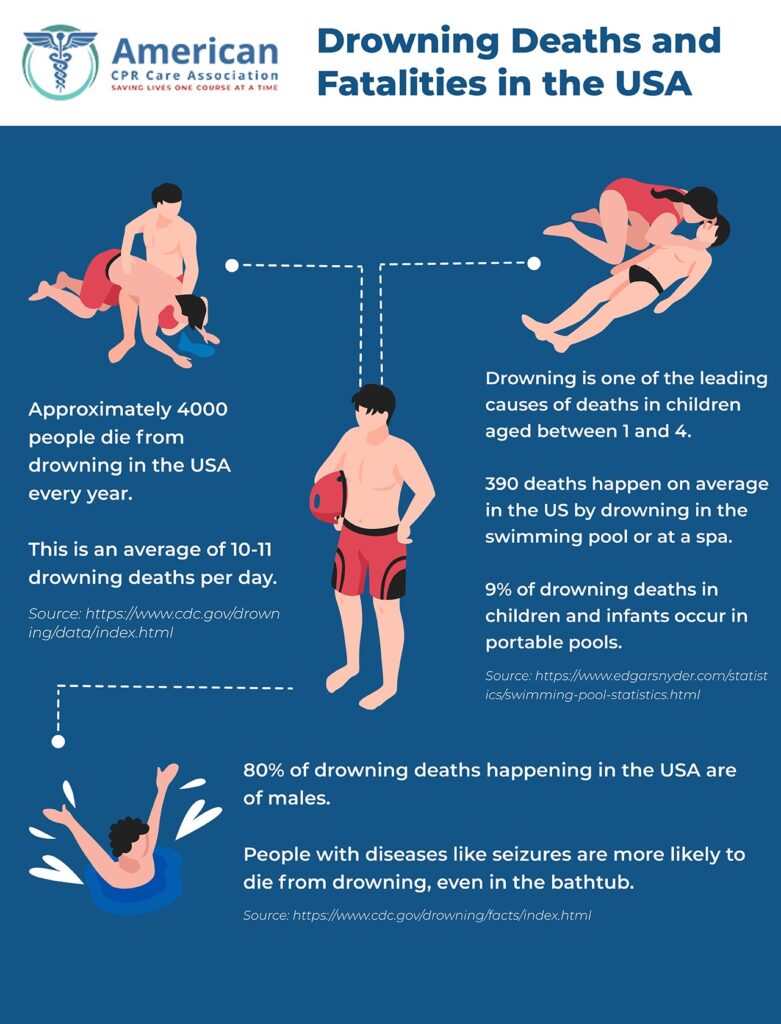
Last Updated On: December 20, 2024
The summer season is all about basking in the sun and taking a dip in the water! Even on weekends, many people flock to swimming pools to enjoy the sun and water. However, the enjoyment can anytime turn into a tragedy. Lack of attention, heat, and exhaustion can lead to disasters like drowning.
Drowning cases are more common among young children. The Center for Disease Control (CDC) shares a heartbreaking reality. They state that drowning is the leading cause of death for children aged between 1-4 years in the United States. An average of 11 people die every day from drowning. The majority of these incidents occur at locations without a lifeguard present.
The CDC also stresses the importance of being prepared in such situations. One crucial safety tool for a swimming pool is CPR. Knowing CPR is essential to saving a life in a drowning situation. When someone is drowning, immediate hands-on CPR can make all the difference.
This blog will explain why you should learn CPR in the vicinity of swimming pools. It will also help you understand how to perform it correctly.

Swimming pools can be a great source of recreation and relaxation. However, they must be properly supervised to ensure safety. With the growing number of accidental drowning cases, it is important to be prepared for an emergency situation. Knowing CPR can help save the life of someone in a drowning situation. It is a critical skill for anyone in or around a swimming pool.
Slips and falls are common around pools. They can be particularly dangerous if the person has a head injury or becomes unconscious in the water. CPR can offer prompt intervention in such cases. It can prevent death in cases of heart attacks or other medical conditions. Knowing CPR can also be lifesaving if a small child accidentally falls into the pool. It can help you quickly assist in retrieving them from the water.
CPR restores blood circulation and oxygen to the brain and other vital organs. In a drowning situation, it is important to quickly administer and perform CPR. First and foremost, assess the situation. You can do so by tapping on their shoulder and asking if they are ok. This step will help you understand the victim’s responsiveness. Next, check if the victim is breathing or not. If the victim is not breathing, immediately begin chest compressions. Before that, call and inform 911 of the situation.
You can follow the CPR procedure as mentioned below:
CPR can be an effective stand-by treatment to increase the likelihood of survival. However, if not done properly, it can do more harm than good. It may break ribs or cause internal damage to the victim. Therefore, the person performing CPR must be well-trained.
Whether you are a swimming teacher, lifeguard, or supervising adult, CPR training is for everyone. It ensures pool safety and the lives of people in the vicinity. In the event of a drowning accident, every second counts.
CPR training prepares you to respond quickly and confidently in the event of a drowning. CPR training is available at the American CPR Care Association. All you have to do is register yourself on the website. You get access to best-in-class training material. The training programme is expert-led. It follows a practical approach.
CPR training covers the basics of water safety. It includes lessons on:
CPR training helps create a safer swimming environment. It teaches how to respond quickly and appropriately in the event of an emergency. CPR training is especially important in the vicinity of swimming pools. It is important to take the time to learn these valuable lifesaving skills.
Learning CPR is very easy. Adults as well as children can easily pick up this critical skill.
Swimming pools are a hub of fun and relaxation, but they also pose significant safety risks, especially for children. Understanding the importance of CPR training in poolside environments is crucial for preventing drowning-related tragedies. The ability to perform CPR can mean the difference between life and death in emergencies.
By equipping yourself with CPR skills, you become a vital safeguard for those around you. Whether you’re a parent, lifeguard, or recreational swimmer, knowing how to respond effectively to emergencies ensures a safer environment for everyone.